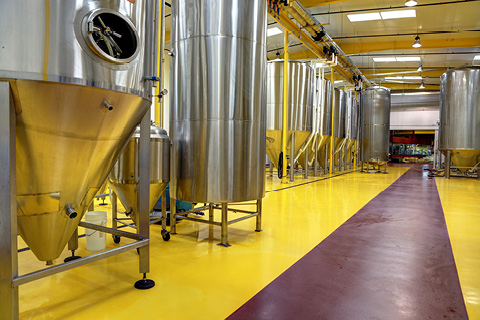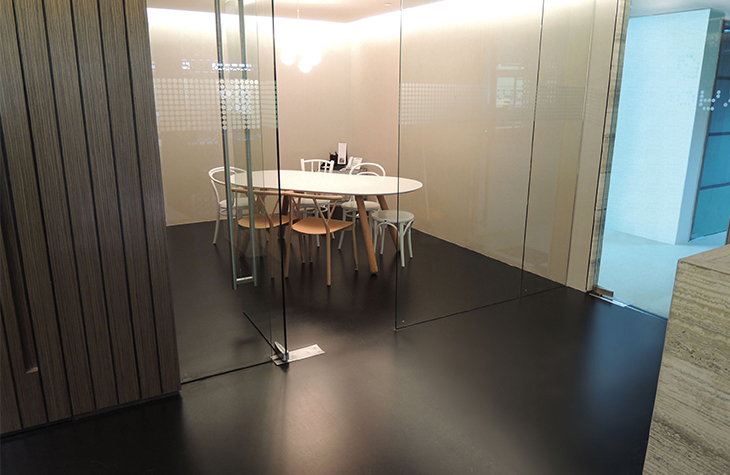Get ready for winter. Flowcrete gives you tips for floor laying.
The winter often means freezing temperatures and precipitation in some form. This means that the execution of thermoset coatings outdoors is generally not possible. But it can also cause problems with indoor installations. Perhaps mainly in new construction but also in existing buildings. There are often cold floors at entrances, locks and near gates.
The most common problems are often in new buildings where the heating is often substandard. Sometimes the floor installation must take place before the house is sealed. Low temperatures and cold floors affect our materials and, in conjunction with high humidity, can also impair adhesion.
As usual, you should always keep an eye on the dew point. Before installation, always check:
- Temperature in the air
- Temperature in the substrate
- The humidity
- The substrate must always have a temperature that is at least 3 degrees above the dew point
To prevent problems during installation in cold premises, it is common to use some form of external temporary heating. Often in the form of fan heaters.
Keep in mind that more than one fan is often needed and they must be switched on well in advance of the installation in order to get some temperature rise in the substrate. As a rule, the fan heaters should be on at least a week in advance.
It is an advantage to direct the fans' hot air flow towards the floor surface in order to create a temperature increase in the substrate. But well in advance of installation, the air flow must be redirected upwards so that no air flow occurs against the floor surface during installation.
If the room needs to be heated before installation. Think of:
- Calculate the power and number of fans based on the room and temperature. More than one fan is often needed.
- Set them out well in advance of installation
- Feel free to direct them towards the floor surface and move them around the room to achieve an even temperature throughout the substrate. A rule of thumb for ideal temperature range is between 15-25o C
- Remember to reorient the fans so they don't blow towards the floor during installation. Do this well in advance of installation
- Ensure that all materials are stored in dry warm premises and are not refrigerated during installation
Recommendations for our different product groups when installing in low temperatures
Duracon - The perfect solution for the cold season
Duracon is the name of our floor systems made of acrylic plastic. It is an acrylic plastic developed for floor systems consisting of MMA (Methyl methacrylate). This plastic is only slightly affected by low temperatures and Duracon flooring systems can be installed very well at very low temperatures, down to 0oC.
Just remember that the lower the temperature, the more catalyst (hardener) is used. Don't forget to check the dew point.
It is even possible to install Duracon floor systems in sub-zero temperatures if you add an accelerator.
Advantages of Duracon:
- Very little affected by low temperatures and can be installed down to 0oC. Can also be installed in freezing temperatures if accelerator is used
- Fast installation and very fast curing, is fully cured after 2 hours at 20oC
- Available as flexible membrane
- Seamless, hygienic and decorative
- Good cleanability
- Durable
The absolute biggest disadvantage of Duracon and all acrylic plastics intended for floor coverings (MMA) is the very intense smell.
Here you often have to work with evacuation fans and other measures to prevent the spread of the smell to adjacent premises and businesses.
Epoxy system during the cold season
Our epoxy systems make up our largest product group with everything from decorative Terrazzo floors to dissipative ESD floors. In between, there are lots of customizable systems.
Everything from simpler painting treatments to thicker coatings for tough environments in the industrial sector.
All epoxy systems are affected by low temperatures. The viscosity changes and they become tough and slow to apply. Noticed very clearly on the self-leveling systems that flow out worse. Even the ventilation becomes worse.
The waterborne painting systems are particularly sensitive to cold subfloors as the water can have difficulty leaving, which can result in a dull and less dirt-resistant surface. Keep an eye on the dew point.
When installing epoxy systems, you should have at least 15o C in air and substrate. Absolute lower limit for the substrate is 10o C. Do not forget that the curing time is greatly extended by low temperatures for all epoxy systems.
This means that the floor must lie and harden longer before it can be used. Perhaps 1–2 days longer than in normal indoor climate, 20oC.
Advantages of Epoxy systems:
- The largest and most common product group for Jointless floors
- There are systems from simple painting treatments to advanced systems for ESD floors
- Seamless, hygienic and decorative
- Durable
- Good cleanability
But remember that epoxy products change greatly with decreasing temperature. Become difficult to work with impaired flow and venting. As a rule, material consumption also increases due to low temperatures.
PU system during the cold season
Our PU systems are a growing product group and are mainly characterized by their flexible properties. PU, which is short for Polyurethane, is the thermoplastic that can
most varied in terms of hardness. Can be modified to anything from hard to very flexible. The flexible properties mean that we often find PU in both membrane and joint products.
Here we can also create soft, silent floors for the public sector. In the spring, we will launch a step sound dampening system built with soft polyurethane that provides a step sound reduction of 16 dB.
PU behaves like the epoxy products and is greatly affected by falling temperature. We recommend a minimum temperature of 15o C in air and substrate. Never below 10o C in the substrate. In some cases, 12o C is the lower limit. See our Product Sheets.
Do not forget that the curing time is greatly extended at low temperatures. In addition, as a rule, material consumption increases. Just like for the epoxy systems. Advantages of PU systems:
- Can be varied the most of all systems in hardness. Everything from hard to very flexible
- Flexible membrane
- Step sound dampening
- Seamless, hygienic and decorative
- Good cleanability
- Durable
In order to avoid free Isocyanates as much as possible and to create as good a working environment as possible, our endeavor is to provide PU systems with only prepolymerized Isocyanates.
PU-Cement system during the cold season
Flowcrete has three different systems with PU-Cement, which is a mixture of, among other things, polyurethane and cement. These are systems that are mainly used in the food industry and in wet environments.
The coating is distinguished by its good thermal properties and can handle the tough load of hot water. Also has good chemical resistance.
Here, the temperature is also important during application. We recommend a minimum of 15o C in air and substrate and never below 12o C. Remember that cement is sensitive to moisture. Always store PU cement in dry, heated rooms. Advantages of PU-Cement system:
- Copes with high loads of hot water, in thicker layers (9mm.) above 100o C (steam)
- Good chemical resistance
- Durable with good slip resistance in wet environments
PU-Cement is a functional but still relatively decorative coating and is available in several colors and designs.
Flowchem functional coatings during the cold season
These vinylester plastic coatings go by the name Flowchem with us and are a purely functional coating. Basically used exclusively for its fantastic resistance to chemicals and can handle most acids and bases.
Used in the chemical and process industry to protect e.g. concrete surfaces against chemical impact from aggressive chemicals.
The material itself changes a little less than epoxy and polyurethane at low temperatures, but we still recommend a minimum temperature of 15o C. in air and substrate. Never below 10o C in the substrate.
Vinyl ester plastic contains solvents and must be handled accordingly.
Advantages of Flowchem functional coatings:
- Very high resistance to chemicals
- Good thermal resistance
Flowchem is a purely functional coating and is in no way designed to be particularly decorative.
Summary
Be prepared for winter and keep an eye on:
- The temperature in air and substrate
- The humidity and the dew point
- Turn on extra heat in good time and keep the material warm.
Remember that in the UK it is winter every year. It is recurring.










